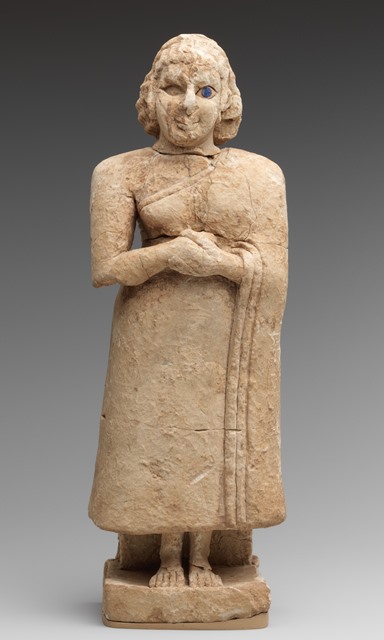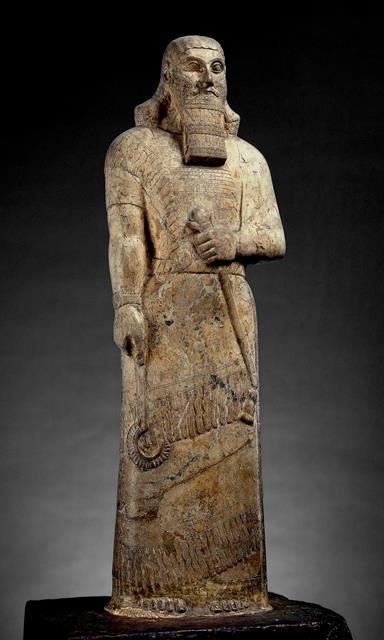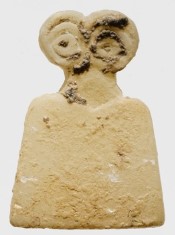 Edit article
Edit articleSeries
Taking Refuge in God beyond the Temple Walls—Psalm 27

Book of Psalms, folios 25v &26r, Or 9901, 18th-19th century. British Library
Confident in God’s help and protection, the speaker in Psalm 27 expresses unflinching fearlessness in the face of an enemy:[1]
תהלים כז:א לְדָוִד יְ־הוָה אוֹרִי וְיִשְׁעִי מִמִּי אִירָא יְ־הוָה מָעוֹז חַיַּי מִמִּי אֶפְחָד.
Ps 27:1 Of David. YHWH is my light and help, whom should I fear? YHWH is the stronghold of my life, of whom should I dread?
With God as a refuge and life’s stronghold (maʿoz), the psalmist is confident, even in the face of an army:
תהלים כז:ב בִּקְרֹב עָלַי מְרֵעִים לֶאֱכֹל אֶת בְּשָׂרִי צָרַי וְאֹיְבַי לִי הֵמָּה כָשְׁלוּ וְנָפָלוּ. כז:ג אִם תַּחֲנֶה עָלַי מַחֲנֶה לֹא יִירָא לִבִּי אִם תָּקוּם עָלַי מִלְחָמָה בְּזֹאת אֲנִי בוֹטֵחַ.
Ps 27:2 When evil men assail me to devour my flesh, it is they, my foes and my enemies, who stumble and fall. 27:3 Should an army besiege me, my heart would have no fear. Should war beset me, still I would be confident.
The view of God as a refuge in the face of enemies is common throughout Psalms.[2] Often in these texts, the speaker prays for God to directly engage the enemy. In Psalm 27, however, the speaker prays instead for an encounter with God in God’s Temple:
תהלים כז:ד אַחַת שָׁאַלְתִּי מֵאֵת יְ־הוָה אוֹתָהּ אֲבַקֵּשׁ שִׁבְתִּי בְּבֵית יְ־הוָה כָּל יְמֵי חַיַּי לַחֲזוֹת בְּנֹעַם יְ־הוָה וּלְבַקֵּר בְּהֵיכָלוֹ.
Ps 27:4 One thing I ask of YHWH, only that do I seek: To live in the house of YHWH all the days of my life, to gaze upon the beauty of YHWH, to frequent His temple.
The Temple, however, is more than just the location of a religious encounter. It is also a refuge, the place where God provides shelter and protection from enemies:
תהלים כז:ה כִּי יִצְפְּנֵנִי בְּסֻכֹּה בְּיוֹם רָעָה יַסְתִּרֵנִי בְּסֵתֶר אָהֳלוֹ בְּצוּר יְרוֹמְמֵנִי.
Ps 27:5 He will shelter me in His pavilion on an evil day, grant me the protection of His tent, raise me high upon a rock.[3]
In God’s sok and ʾohel, the speaker, raised up over the enemies, gains the confidence that suffuses the offering of jubilant sacrifices:
תהלים כז:ו וְעַתָּה יָרוּם רֹאשִׁי עַל אֹיְבַי סְבִיבוֹתַי וְאֶזְבְּחָה בְאָהֳלוֹ זִבְחֵי תְרוּעָה אָשִׁירָה וַאֲזַמְּרָה לַי־הוָה.
Ps 27:6 Now is my head high over my enemies roundabout. I sacrifice in His tent with shouts of joy, singing and chanting a hymn to YHWH.
In the psalm, both God and the Temple are a refuge for the speaker.
The Pairing of God and the Temple as Refuge in Psalms
We find a similar combination of themes elsewhere in Psalms. For example, Psalm 61 declares:
תהלים סא:ד כִּי הָיִיתָ מַחְסֶה לִי מִגְדַּל עֹז מִפְּנֵי אוֹיֵב. סא:ה אָגוּרָה בְאָהָלְךָ עוֹלָמִים אֶחֱסֶה בְסֵתֶר כְּנָפֶיךָ סֶּלָה.
Ps 61:4 For You have been my refuge, a tower of strength against the enemy. 61:5 O that I might dwell in Your tent forever, take refuge under Your protecting wings. Selah.
The shared Hebrew root, ח.ס.ה/י, meaning “refuge”—in the noun machseh (v. 4) and the verb ʾecheseh (v. 5)—links the two verses, both conceptually and linguistically connecting the speaker’s request for eternal refuge in the Temple to the idea that God is a refuge.
Psalm 52 and Psalm 84 connect these themes by contrasting those who seek God's protection in the temple with those who do not. In Psalm 52, we read:
תהלים נב:ט הִנֵּה הַגֶּבֶר לֹא יָשִׂים אֱלֹהִים מָעוּזּוֹ וַיִּבְטַח בְּרֹב עָשְׁרוֹ יָעֹז בְּהַוָּתוֹ. נב:י וַאֲנִי כְּזַיִת רַעֲנָן בְּבֵית אֱלֹהִים בָּטַחְתִּי בְחֶסֶד אֱלֹהִים עוֹלָם וָעֶד.
Ps 52:9 “Here was a fellow who did not make God his refuge, but trusted in his great wealth, relied upon his mischief.” 52:10 But I am like a thriving olive tree in God’s house; I trust in the faithfulness of God forever and ever.
Similarly, in Psalm 84, the speaker declares:
תהלים פד:יא כִּי טוֹב יוֹם בַּחֲצֵרֶיךָ מֵאָלֶף בָּחַרְתִּי הִסְתּוֹפֵף בְּבֵית אֱלֹהַי מִדּוּר בְּאָהֳלֵי רֶשַׁע. פד:יב כִּי שֶׁמֶשׁ וּמָגֵן יְ־הוָה אֱלֹהִים חֵן וְכָבוֹד יִתֵּן יְ־הוָה לֹא יִמְנַע טוֹב לַהֹלְכִים בְּתָמִים. פד:יג יְ־הוָה צְבָאוֹת אַשְׁרֵי אָדָם בֹּטֵחַ בָּךְ.
Ps 84:11 Better one day in Your courts than a thousand [anywhere else]; I would rather stand at the threshold of God’s house than dwell in the tents of the wicked. 84:12 For YHWH God is sun and shield; YHWH bestows grace and glory; He does not withhold His bounty from those who live without blame. 84:13 O YHWH of hosts, happy is the man who trusts in You.
These psalms thus present God as refuge and Temple as refuge as synonymous.
Is It Literal or Metaphorical Refuge?
The generations of readers who have recited these psalms without the existence of a physical temple have naturally interpreted the refuge imagery metaphorically: just as descriptions of God as a refuge are not literal, so, too, dwelling in God’s house need not refer to being in a physical location.
At the time of the composition of the book of Psalms, however, the Temple was an actual place that served as the center of religious activities, and thus this image may have originally been meant literally. Scholars have therefore looked for a real-world context that would explain the development of the idea of God and the Temple as sites of refuge.
Psalms for Those Seeking Asylum?
For example, Benẓion Dinur (1884–1973), an Israeli historian who also served as minister of education and culture, has argued that Psalm 27 would have been recited by an inadvertent killer seeking entry into one of the cities of refuge (Num 35; Deut 19:1–13).[4]
Others point to evidence of a custom that a person could escape to God’s altar to avoid punishment. The Covenant Collection (Exod 21–23) seems to allude to a such a practice:
שׁמות כא:יד וְכִי יָזִיד אִישׁ עַל רֵעֵהוּ לְהָרְגוֹ בְעָרְמָה מֵעִם מִזְבְּחִי תִּקָּחֶנּוּ לָמוּת.
Exod 21:14 When a man schemes against another and kills him treacherously, you shall take him from My very altar to be put to death.
In this case, non-accidental murderers face removal from God’s altar, where they might have illicitly sought refuge.
Temple Asylum vs. God as Refuge
The problem here, as the Bible scholar Brevard Childs (1923–2007) has noted, is that interpreting every reference to God as refuge in Psalms against the background of a very specific legal institution “results in an artificial straining of the evidence.”[5] Outside Psalms and legal material, the only biblical evidence for such an institution comes from failed attempts to seek refuge. For instance, David’s son Adonijah’s attempt to usurp the throne ends with Adonijah clinging to the horns of the altar:
מלכים א א:נא וַיֻּגַּד לִשְׁלֹמֹה לֵאמֹר הִנֵּה אֲדֹנִיָּהוּ יָרֵא אֶת הַמֶּלֶךְ שְׁלֹמֹה וְהִנֵּה אָחַז בְּקַרְנוֹת הַמִּזְבֵּחַ לֵאמֹר יִשָּׁבַע לִי כַיּוֹם הַמֶּלֶךְ שְׁלֹמֹה אִם יָמִית אֶת עַבְדּוֹ בֶּחָרֶב.
1 Kgs 1:51 It was reported to Solomon: “Adonijah is in fear of King Solomon and has grasped the horns of the altar, saying, ‘Let King Solomon first swear to me that he will not put his servant to the sword.’”
Adonijah is removed from the altar and released pending compliant behavior, but is ultimately killed (1 Kgs 1:51; 2:3–25).
One of his allies, Joab, is killed at the altar to which he fled, because Solomon rejects his bid to avoid punishment (1 Kgs 2:28–31). Finally, Nehemiah is advised to seek refuge in the temple when his life is threatened, but he refuses because the advice is a trap to induce him to violate Temple law (Neh 6:10–13). Thus, there is not enough evidence to support claims that asylum, as a legal institution, would have inspired the composition of multiple refuge psalms.
Asylum vs. Permanent Refuge
More fundamentally, in Psalms, shelter in the temple is imagined as a permanent arrangement—as when the speaker in Psalm 27 hopes to dwell in God’s house, kol yeme chayay, “all the days of my life.”[6] We have no evidence, however, to corroborate a practice of finding permanent legal asylum in the Temple.
Instead of looking for an explanation for the motifs of God and the Temple as refuge in a legal institution of asylum, we should examine how divine encounters in a temple were imagined in the ancient Near East.
Placing a Petitioner’s Figurine Before a God
Mesopotamian worshipers would deposit statues of themselves in temples in order to establish their permanent presence before the gods. Examples come from sites such Eshnunna, Nippur, Girsu, Mari; one of the most famous ones is a statue of the Assyrian King Assurnasirpal II (ruled 883–859 BCE), originally deposited in the temple of the goddess Ishtar. All of these statues are characterized by their eyes gazing forward, looking, originally, toward the statue of the deity before whom they were placed.

|

|

|

Some of the earliest examples, from ca. 3700–3500 B.C.E., come from Tell Brak, and are commonly (though somewhat misleadingly) called “eye idols” because they consist of well-articulated eyes atop an otherwise simple body. All of these objects suggest that they were fashioned with an emphasis on an imagined visual encounter between the represented depositors and the deity. In addition to signifying the depositors’ permanent presence before the gods, the statues ensured that the depositors “made eye contact.”
Words instead of Statues
There is no evidence that Israelites used comparable statuary, so it is unlikely that the psalmists were working with an equivalent material object. Rather, they expressed the same sentiments with words. Just as the statues embody the combination of a desire for permanent presence in a temple with the visual encounter with a deity, so the psalms use poetry to express the same ideas.[7]
Seeking a Face-to-Face with God
Indeed, in Psalm 27, the speaker not only asks to dwell in God’s temple and gaze at God’s beauty (v. 4), but also prays to see God’s face:
תהלים כז:ח לְךָ אָמַר לִבִּי בַּקְּשׁוּ פָנָי אֶת פָּנֶיךָ יְ־הוָה אֲבַקֵּשׁ. כז:ט אַל תַּסְתֵּר פָּנֶיךָ מִמֶּנִּי אַל תַּט בְּאַף עַבְדֶּךָ עֶזְרָתִי הָיִיתָ אַל תִּטְּשֵׁנִי וְאַל תַּעַזְבֵנִי אֱלֹהֵי יִשְׁעִי.
Ps 27:8 In Your behalf my heart says: “Seek My face!” O YHWH, I seek Your face. 27:9 Do not hide Your face from me; do not thrust aside Your servant in anger. You have ever been my help. Do not forsake me, do not abandon me, O God, my deliverer.[8]
Similarly, Psalm 63 couples a description of seeing God in the Temple—כֵּן בַּקֹּדֶשׁ חֲזִיתִיךָ לִרְאוֹת עֻזְּךָ וּכְבוֹדֶךָ, “I shall behold You in the sanctuary, and see Your might and glory” (v.3)—with finding עֶזְרָתָה (ʿezratah), “help,” and protection בְצֵל כְּנָפֶיךָ (vetzel kenafecha), “in the shadow of your [God’s] wings” (v. 8).[9]
Crucially, then, the words, like the statues, evoke something between physical reality and metaphor. On the one hand, those who deposited a votive statue or recited a psalm understood the fiction of establishing a permanent presence in a temple and finding permanent protection there. On the other hand, both the words and the statues refer to religious activities that occurred in particular physical locations and to the all-too-real emotions they engendered. Each, in its own way, expresses the desire to extend those experiences beyond the specific moment and allow it to continue even once the person has left the Temple.
A Sudden Shift into the Temple
Notably, Psalm 27 opens with the speaker lamenting the attacks of enemies outside the Temple, but when the speaker begins to praise God, the location suddenly shifts to singing and sacrificing in God’s tent:[10]
תהלים כז:ו וְעַתָּה יָרוּם רֹאשִׁי עַל אֹיְבַי סְבִיבוֹתַי וְאֶזְבְּחָה בְאָהֳלוֹ זִבְחֵי תְרוּעָה אָשִׁירָה וַאֲזַמְּרָה לַי־הוָה.
Ps 27:6 Now is my head high over my enemies roundabout. I sacrifice in His tent with shouts of joy, singing and chanting a hymn to YHWH.
The transition from lament to praise, from outside the Temple to inside the Temple, is also a transition from danger to safety. The acts of praise and sacrifice, of publicly acknowledging salvation after an encounter with the enemy, celebrate this feeling of safety in the Temple.
The speaker did not remain in the Temple forever, but asking to dwell in God’s temple “all the days of my life” (v. 4) and seeking to see and be seen by God’s face (vv. 7–8), allows the speaker to carry the feeling of relief beyond the particular moment of praise and could well explain the speaker’s sense of finding permanent protection in the Temple.
Psalm 27: Then and Now
In current Ashkenazi liturgy, Psalm 27 accompanies the high holiday season, from the first of Elul through the end of Shemini Atseret, on 22 Tishri. Although this custom is relatively recent, it has prompted various reflections on the connections between the biblical text and the religious themes of this time of year on the Jewish calendar.[11] On its own, however, nothing in the psalm suggests that in biblical times it was used during any particular festival, much less that it was associated with the festivals of the Hebrew Bible’s seventh month.
Rather, Psalm 27 offers us a glimpse into one aspect of what we might call the Hebrew Bible’s Temple theology. The Temple was the physical space that gave expression to images of God as protector. The person suffering during a crisis hoped to be there, because that was the place where he or she would arrive to give thanks for having been saved. Such an individual hoped that the emotionally laden divine-human encounter that occurred there could last well beyond the Temple’s walls and the moment of thanksgiving there.
TheTorah.com is a 501(c)(3) nonprofit organization.
We rely on the support of readers like you. Please support us.
Published
September 25, 2022
|
Last Updated
March 30, 2024
Previous in the Series
Next in the Series
Footnotes

Prof. Shalom E. Holtz is professor of Bible at Yeshiva University. He did his Ph.D. at the University of Pennsylvania. He is the author of Neo-Babylonian Court Procedure (Cuneiform Monographs 38; Leiden: Brill, 2009) and Neo-Babylonian Trial Records (Society of Biblical Literature, 2014) and Praying Legally (Brown Judaic Studies, 2019).
Essays on Related Topics:





